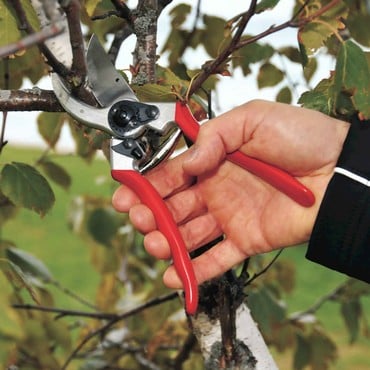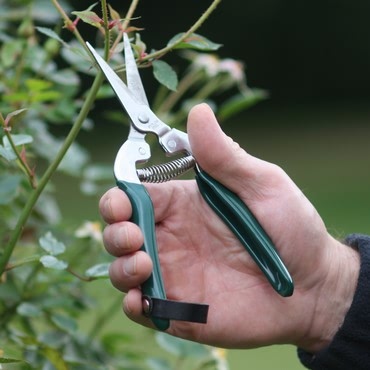The big summer harvest has reached a crescendo in the kitchen garden this month, with large trugs full of produce making their way to the kitchen. We have been picking huge bowls full of blueberries, raspberries and, in the last few days, blackberries. French and runner beans and courgettes have also been providing a bumper crop with much more to come. The greenhouse is producing more cucumbers and tomatoes than we can eat and the aubergine harvest has been the best we have had in recent years. They have really enjoyed the hot sunny summer weather that we have experienced so far this year.
We have been digging up our early potatoes this month. We always grow Charlotte and this year the plants have provided a bumper crop, with more plants still to dig. We also dug up the garlic and shallots and left them to dry in the sunshine before preparing them for storage. The garlic, still a reasonable size despite suffering from rust, has been plaited and hung in the larder for use over the coming months, and the shallots have been stored in vegetable bags. Our red onions are a really good size now and will soon be ready to join their counterparts in the larder. We will wait for the leaves to brown before harvesting them.
Where we have created empty spaces, we have dug the ground over and prepared it for a new crop by incorporating home-made 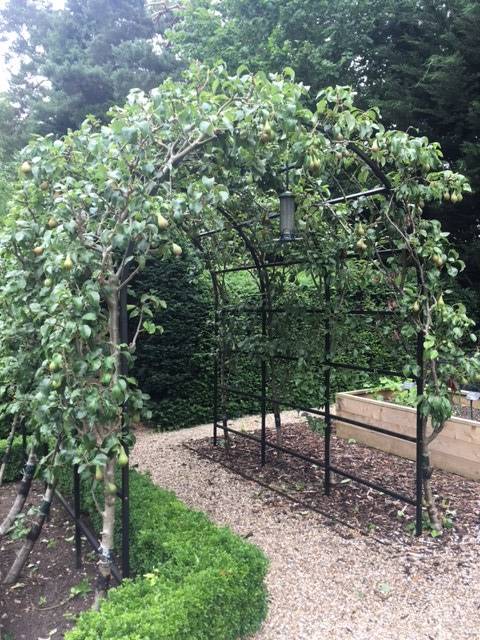 compost and farmyard manure into the soil. We currently have seed trays with small cabbage and broccoli plants that will soon be ready to plant out. We prefer to nurse these in the cold frame until they are good sized young plants before they are planted out in their final growing space.
compost and farmyard manure into the soil. We currently have seed trays with small cabbage and broccoli plants that will soon be ready to plant out. We prefer to nurse these in the cold frame until they are good sized young plants before they are planted out in their final growing space.
The weather has settled into a more traditional theme in the latter part of the month, with showers keeping the garden irrigated and the water butts topped up. This has allowed us more time spent gardening than carrying watering cans. It has also sent plants into a growth spurt, in particular our espalier fruit trees. We would normally be pruning these during August, but they have put on so much growth that we pruned them earlier, with the intention of a follow-up pruning in late august.We pruned side shoots down to three leaves above the basal cluster to create fruiting spurs for next year. Shoots emerging from side-shoots were pruned back to one leaf above the base. We already have an established framework of branches on our trees, but a couple of years ago we replaced their supports to taller ones. This allows us the opportunity to train more horizontal branches from the tree and we have now tied these in to increase the height of the plants. We have also pruned our pear arch using the same principles. Pruning the trees is a hugely satisfying job as the transformation is quite dramatic. It is lovely to see the neat framework restored and to allow light on to the swelling fruits. If 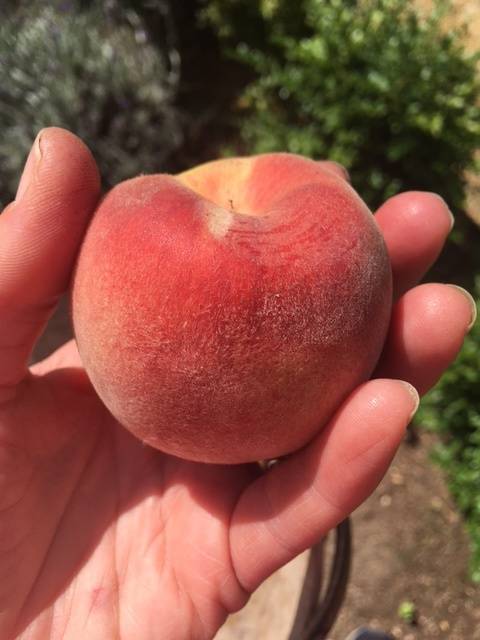 you are a neat and tidy gardener, this is definitely a job for you!
you are a neat and tidy gardener, this is definitely a job for you!
Our peach and nectarine trees, planted two summers ago, had also put on significant growth. Pruning them revealed a bumper crop hidden under the foliage and at the end of July we harvested the first ever peach in Stephanie’s Kitchen Garden. The smell was amazing and it tasted even better. There are many more fruits ripening on the tree and we are hoping the resident squirrel population will leave some of them for us! So far they are untouched but we are inspecting the fruits daily and, at the first sign of attack, we will harvest the rest of the crop to ripen in the house rather than on the tree.
Uncovering the ripening fruits on the trees has also exposed them to other possible pests and we need to do our best to protect them. As soon as pruning was complete, we hung wasp traps amongst the branches. So far this year there has been no sign of wasps, but a couple of years ago they descended overnight and caught us napping. Now we make a point of getting the traps in early to make sure they don’t infest our crop.
Other pests that we are on the look-out for at this time of year are butterflies and whitefly. The broccoli and sprout plants are now a really good size and we are being vigilant to make sure the net of the vegetable cage doesn’t touch any leaves, allowing butterflies to lay their eggs through it. We make it part of our weekly routine to inspect the leaves for signs of whitefly. This is a pest that visits us most years so we will be ready with some soapy water to spray on should any appear.
Our squash plants are currently growing vigorously up and over the obelisks; thoroughly enjoying the warm conditions and their 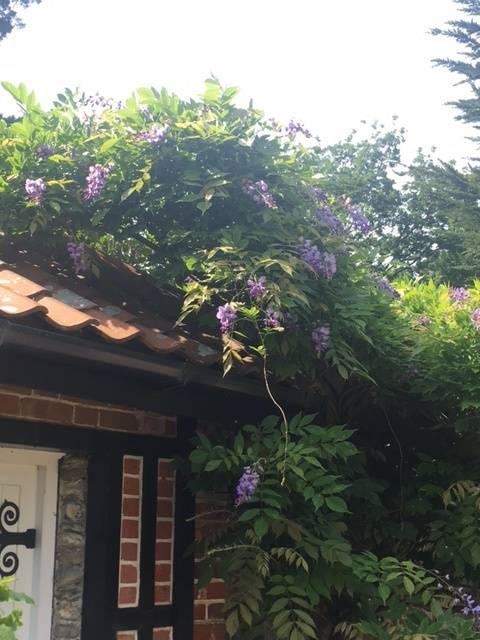 weekly seaweed feed. A couple of weeks ago we pinched out the growing shoots to encourage the plant to concentrate its efforts on swelling the existing baby squashes instead of a garden takeover bid! Inside the greenhouse, the tomato plants are also reaching for the skies. Each plant is now at the top of its support and has six trusses of fruit, so we have pruned out the main stem so that the plant can focus on ripening and growing the existing tomatoes. The cucumber plants are also growing a mile a minute and clinging on to any host they can find. Each year we train them up to the roof of the greenhouse and along the ridge to give them plenty of room to spread their legs. They, in turn, provide welcome shade to the plants growing on the staging beneath them.
weekly seaweed feed. A couple of weeks ago we pinched out the growing shoots to encourage the plant to concentrate its efforts on swelling the existing baby squashes instead of a garden takeover bid! Inside the greenhouse, the tomato plants are also reaching for the skies. Each plant is now at the top of its support and has six trusses of fruit, so we have pruned out the main stem so that the plant can focus on ripening and growing the existing tomatoes. The cucumber plants are also growing a mile a minute and clinging on to any host they can find. Each year we train them up to the roof of the greenhouse and along the ridge to give them plenty of room to spread their legs. They, in turn, provide welcome shade to the plants growing on the staging beneath them.
In the wider gardens, late July saw us undertake the huge task of pruning our wisteria plants. They have put on a fantastic display this year and are currently treating us to a second flowering. We spent a couple of gloriously sunny days removing the new long tendrils to five or six leaves, taking care not to disturb any existing flowers or flower buds. Any new shoots that we wanted to keep, were then tied in to the support. This is an enjoyable task, until you accidentally disturb a nesting pigeon that you haven’t spotted amongst the foliage!
Here are some of the jobs we’ve got planned for August in Stephanie’s Kitchen Garden:
- Apply nemaslug to the soil.
- Feed crops regularly.
- Trim box hedges.
-
Trim standard bay trees.
- Keep watering when conditions are dry.
We’re always here to offer help and support. Go to the Ask the Expert section on our website and email horticultural advisor Jo Blackwell with your queries and she’ll do her best to help.
We’re busy tweeting about all things Harrod Horticultural – what we’re doing, special offers, gardening tips and advice and you can always use Twitter or Facebook to get in touch with us as well. With our webteam manning the Tweet desks and Facebook site, you can be sure you will get the best service we can offer.
Our 108 page catalogue is out now and packed full of gardening ideas and products to solve the problems every gardener faces, plus plenty more seasonal ideas for harvesting, storage and preserving.



















